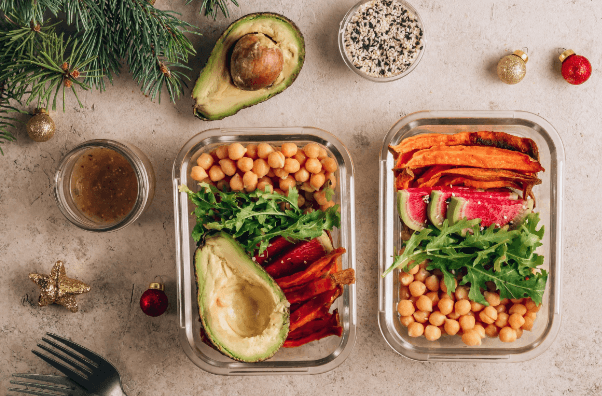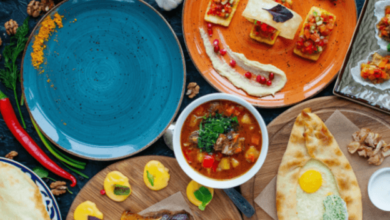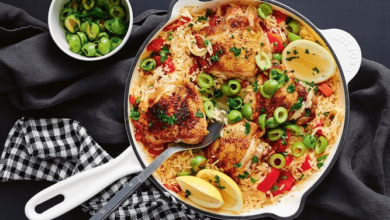“The Ultimate Guide to Healthy Meal Prep: Tips and Recipes”

Healthy meal prep has become more than just a trend—it’s a lifestyle that can transform your health, save time, and keep you on track with your fitness goals. Whether you’re a busy professional, a student, or a parent, meal prepping can be the key to eating nutritious meals without the stress of daily cooking. In this ultimate guide, we’ll explore everything you need to know about healthy meal prep, from tips to get started to a variety of delicious recipes that will make your weekly meal planning a breeze.
Why Meal Prep Matters
The benefits of meal prep are extensive, but at its core, meal prepping allows you to control your food intake, make healthier choices, and save both time and money. When you take the time to prepare meals ahead of time, you’re less likely to reach for fast food or unhealthy snacks when hunger strikes.
Meal prep can also be a powerful tool for those with specific dietary goals, such as weight loss, muscle building, or maintaining a balanced diet. By planning and preparing your meals in advance, you ensure that each meal is tailored to your nutritional needs.
Getting Started with Meal Prep
Starting a healthy meal prep routine can feel overwhelming, but with a few simple steps, you can make the process smooth and efficient. Here are some tips to get you on the right track:
1. Plan Your Meals:
Begin by deciding what meals you’ll prepare for the week. Consider breakfast, lunch, dinner, and snacks. Make sure your plan includes a balance of protein, healthy fats, and carbohydrates. Look for recipes that are easy to prepare and that you enjoy eating, as you’ll be more motivated to stick with the plan.
2. Keep It Simple:
When you’re first starting out, keep your meals simple. You don’t need to create gourmet dishes for every meal. Focus on recipes that require minimal ingredients and preparation. As you become more comfortable with the process, you can experiment with more complex dishes.
3. Invest in Quality Containers:
One of the key aspects of successful meal prep is proper storage. Invest in a set of high-quality, airtight containers that will keep your meals fresh throughout the week. Glass containers are a great option because they are durable, reusable, and safe to reheat.
4. Batch Cooking:
Batch cooking is a technique where you cook large quantities of a particular food, then portion it out for meals throughout the week. This is especially helpful for proteins like chicken, fish, or tofu, as well as grains like rice or quinoa. Cook once, and you’ll have multiple meals ready in no time.
5. Make Time for Prep:
Set aside a specific time each week for meal prepping. Sunday afternoons are a popular choice, but any day that fits into your schedule works. During this time, you can cook, chop vegetables, portion out snacks, and prepare anything else you need for the week.
6. Stay Organized:
Organization is key when it comes to meal prep. Create a shopping list based on your meal plan, and make sure you have everything on hand before you start cooking. This will save time and reduce stress.
Nutritional Guidelines for Healthy Meal Prep
To ensure your meal prep is as healthy as possible, it’s important to follow basic nutritional guidelines. Here’s a breakdown of the key components to include in your meals:
1. Lean Proteins:
Protein is essential for muscle repair, immune function, and maintaining a healthy metabolism. Aim to include lean proteins in each meal, such as chicken breast, turkey, tofu, tempeh, lentils, and fish. These options are low in unhealthy fats and packed with nutrients.
2. Whole Grains and Complex Carbs:
Carbohydrates are the body’s primary source of energy, but not all carbs are created equal. Focus on whole grains and complex carbs, such as brown rice, quinoa, oats, and sweet potatoes. These foods are high in fiber and will keep you feeling full for longer.
3. Healthy Fats:
Incorporating healthy fats into your diet is essential for brain function, hormone balance, and heart health. Choose sources of unsaturated fats like avocado, olive oil, nuts, and seeds. Be mindful of portion sizes, as fats are calorie-dense.
4. Vegetables:
Vegetables should make up a large portion of your meals. They’re low in calories but packed with vitamins, minerals, and fiber. Aim to include a variety of colorful vegetables, such as leafy greens, peppers, carrots, broccoli, and zucchini.
5. Fruits:
Fruits provide natural sweetness and are rich in antioxidants, vitamins, and fiber. Use them as snacks or incorporate them into your meals, such as adding berries to breakfast or slices of apple to a salad.
Easy Meal Prep Recipes
To help you get started, here are some simple, nutritious recipes that can be prepped ahead of time and enjoyed throughout the week:
1. Grilled Chicken and Quinoa Bowls
- Ingredients:
- 4 boneless, skinless chicken breasts
- 1 cup quinoa
- 2 cups water
- 1 bell pepper, sliced
- 1 cucumber, sliced
- 1 avocado
- Olive oil, salt, and pepper for seasoning
- Directions:
- Season the chicken breasts with olive oil, salt, and pepper, then grill or bake until fully cooked.
- Cook the quinoa according to package instructions (usually 1 cup quinoa to 2 cups water).
- Slice the vegetables and avocado.
- Portion out the quinoa, chicken, and vegetables into containers. Top with sliced avocado before serving.
2. Veggie Stir-Fry with Tofu
- Ingredients:
- 1 block firm tofu, pressed and cubed
- 2 cups broccoli florets
- 1 red bell pepper, sliced
- 1 zucchini, sliced
- 1 tablespoon soy sauce
- 1 tablespoon sesame oil
- 1 teaspoon ginger, minced
- Directions:
- Heat sesame oil in a pan, then add the cubed tofu. Cook until golden brown on all sides.
- Add the vegetables and cook until tender, then stir in soy sauce and ginger.
- Divide the stir-fry into meal prep containers and serve with brown rice or quinoa.
3. Overnight Oats
- Ingredients:
- 1 cup rolled oats
- 1 cup almond milk
- 1 tablespoon chia seeds
- 1 teaspoon honey
- 1/2 cup berries (strawberries, blueberries, etc.)
- Directions:
- In a jar or container, combine the oats, almond milk, chia seeds, and honey.
- Stir well, cover, and refrigerate overnight.
- In the morning, top with fresh berries and enjoy.
4. Turkey and Sweet Potato Skillet
- Ingredients:
- 1 pound ground turkey
- 2 medium sweet potatoes, diced
- 1 onion, chopped
- 2 cloves garlic, minced
- 1 teaspoon paprika
- 1 tablespoon olive oil
- Salt and pepper to taste
- Directions:
- Heat olive oil in a skillet and cook the ground turkey until browned.
- Add the chopped onion and garlic, cooking until softened.
- Stir in the diced sweet potatoes and paprika. Cover and cook until the sweet potatoes are tender.
- Portion out into containers for a filling, high-protein meal.
Storing and Reheating Your Meals
Once your meals are prepped, it’s essential to store them properly to maintain freshness and taste. Here are some tips on storing and reheating your meal prep dishes:
1. Use Airtight Containers:
Store meals in airtight containers to prevent them from spoiling quickly. Glass containers are great for reheating, but BPA-free plastic containers work as well.
2. Refrigerate or Freeze:
Meals that will be eaten within 3-4 days can be kept in the refrigerator. For meals that need to last longer, freezing is the best option. Make sure to label each container with the date it was prepared to keep track of freshness.
3. Reheat Safely:
When it’s time to enjoy your prepped meal, reheat it thoroughly in the microwave or oven. If reheating in the microwave, cover the container with a microwave-safe lid or a damp paper towel to prevent the food from drying out.
Meal Prep Mistakes to Avoid
Even with the best intentions, meal prepping can sometimes go awry. To help you avoid common pitfalls, here are a few mistakes to steer clear of:
1. Over-Prepping:
It’s easy to get excited and prepare too much food at once. Start small, prepping just a few meals for the week, and gradually increase as you become more comfortable with the process.
2. Lack of Variety:
Eating the same thing every day can lead to food boredom, which makes it harder to stick to your meal plan. Mix up your recipes and rotate between different proteins, vegetables, and grains to keep things interesting.
3. Not Factoring in Leftovers:
If you frequently have leftovers from dinner, incorporate those into your meal prep plan. This can save time and prevent food waste.
Conclusion
Healthy meal prep is a game-changer for anyone looking to eat better, save time, and stay consistent with their dietary goals. By planning your meals, keeping them simple, and using nutritious ingredients, you can set yourself up for success each week. With the recipes and tips provided in this guide, you’ll be well on your way to mastering the art of meal prep. Happy prepping!


